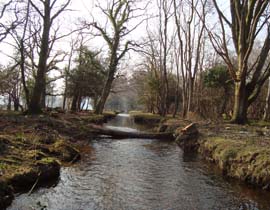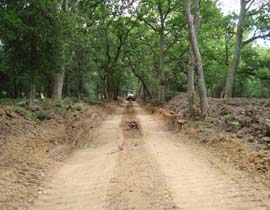Fletchers Thorns after restoration:
What were the issues?
 This Site of Special Scientific Interest (SSSI) is in unfavourable declining condition due to the effects of the artificially straightened channel, which is causing increased erosion of the river bed and limited channel habitat diversity.
This Site of Special Scientific Interest (SSSI) is in unfavourable declining condition due to the effects of the artificially straightened channel, which is causing increased erosion of the river bed and limited channel habitat diversity.
As a result of this incised channel, there is no seasonal inundation of the surrounding grassland, scrub and woodland habitats, and no interaction with the floodplain.
How did we fix them?
The remedy identified to achieve favourable condition was to restore the original meandering stream and then infill the redundant straightened (drain) channel. See the results in the photo gallery above.
The last 100m of straightened channel cuts through Queen Bower Scheduled Ancient Monument.
 This section was infilled in accordance with the conditions set out in the Scheduled Monument Clearance issued by English Heritage.
This section was infilled in accordance with the conditions set out in the Scheduled Monument Clearance issued by English Heritage.
The work also includes some scrub and secondary woodland clearance from Fletchers Thorns lawn.
There is one footbridge, one concrete ford and two gravel fords along the length of the watercourse.
The concrete ford and footbridge will be maintained for operational and public access. The two gravel fords will be maintained for Agister, Keeper and commoner access.
(See top for photo before restoration, right during restoration and above gallery or below 360 photo for following restoration).
Restored meanders, shallow river bed and easily passable ford for livestock and humans.
Stream restoration
The stream at Fletchers Thorns was straightened in Victorian times to quickly drain that part of the forest. This canalisation created unseen problems at the time. Through HLS funding the original meanders were identified and reinstated with the straightened section being in filled and returned back to Forest. The stream is now back to its original course and interacting naturally with its floodplain.
